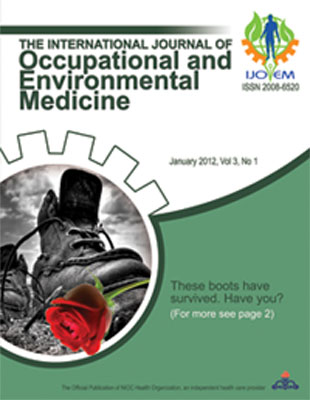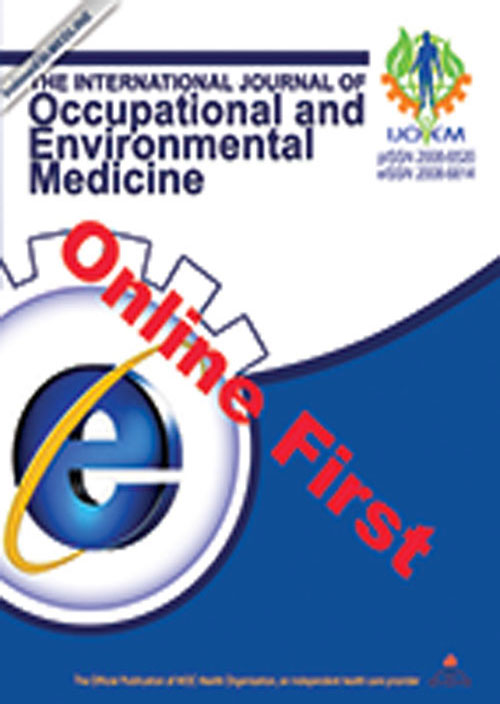فهرست مطالب

International Journal of Occupational and Environmental Medicine
Volume:2 Issue: 3, July 2011
- تاریخ انتشار: 1390/04/04
- تعداد عناوین: 9
-
-
Page 133The currently reactor wreckage in Fukushima raised the following important questions: Is our knowledge of the possible dangers of ionizing radiation sufficient to warrant special action? What is the role of the medical community in technical radiation accidents from Windscale to Fukushima? What is the role of the medical community in terrorist radiation attacks? Are we prepared for those challenges? How can medical services communicate information in the media framework? What have we learned recently? And, what should be improved? In this review of the current literature on ionizing radiation, we try to answer these questions. Our conclusion is that medical services have to improve their communication skills and convince the public that the dangers of ionizing radiation can be quantitated within certain limits to support a qualified discussion about its risks and benefits.
-
Page 143BackgroundLead toxicity has been reported to affect hematopoietic, nervous, reproductive, cardiovascular and urinary tract systems. Many investigators have so far studied the effects of high blood lead levels on pregnancy outcomes.ObjectiveTo investigate the effects of elevated maternal blood lead during pregnancy on some trace elements and pregnancy outcomes.MethodsBlood lead and plasma copper, iron and zinc were measured in 349 pregnant women with a mean±SD age of 27.0±4.8 years, and gestational age of 21.8±3.1 weeks, at recruitment using atomic absorption spectrophotometer. Maternal and fetal outcomes were recorded during follow-up and at delivery, respectively. A blood lead level of ≥10 µg/dL was considered high.ResultsWomen with elevated blood lead had significantly higher plasma copper and iron and lower plasma zinc than women with low blood lead level (<10 µg/dL). Blood lead level correlated with maternal hemoglobin concentration (r=‑0.1054, p=0.051) and total white blood cell count (r=0.1045, p=0.053). Hypertension, malaria and low birth weight were significantly higher (p<0.05) in women with elevated blood lead than in those with low blood lead level.ConclusionComplications of pregnancy may be induced by a high blood lead level possibly through the alterations in trace element metabolism.
-
Page 157BackgroundMusculoskeletal disorders (MSDs) are common among employees throughout the world, particularly in high risk groups such as nurses.ObjectiveTo determine the prevalence of MSDs among nurses in a large hospital in Ahwaz, southwestern Iran, and to examine its correlation with gender, age, shift working, years at service and smoking.MethodsUsing a self-reported questionnaire-based cross-sectional study, Nordic questionnaire for MSDs was disseminated to all inpatient hospital paramedics (n=195) in a large hospital in Ahwaz.ResultsQuestionnaires of 161 participants were completed and returned back for analysis (response rate of 83%). The reported prevalence of MSDs was very high in the studied paramedics so that more than 90% of them reported at least one MSD in last week. The most prevalent site affected was that of neck (64%) followed by head (62.1%), knees (54.7%) and wrists/hands (49.7%); the least frequent disorder was that of elbows (14.3%). MSD was more common in females and increased with age and years of service. Non-shift workers reported more neck and elbows MSDs than shift workers.ConclusionConsidering the very high prevalence of MSDs among paramedics, it is suggested that they engage in an exercise program at their work place to lower the risk of MSDs and promote working efficiency
-
Page 162
-
Page 166BackgroundAuthorship of peer-reviewed publications can create conflict among academics.ObjectiveTo document authorship conflicts of academics at a tertiary faculty.MethodsAn anonymous questionnaire eliciting authorship conflicts and knowledge of authorship criteria was administered online to 154 academic staff members at a New Zealand university.Results43 academics responded, a response rate of 27.9%. About half of the academics reported authorship conflicts, mainly regarding ownership of data, gift authorship and academic competition. Of the 43 academics, 31 were aware of formal authorship criteria but only 21 could identify the appropriate source. 23 academics correctly identified all the appropriate criteria for authorship according to the International Committee of Medical Journal Editors guidelines.ConclusionAuthorship conflicts are prevalent in a New Zealand university that may be related to lack of knowledge of authorship criteria.
-
Page 172In occupational and environmental health research, individual, group and community research participants have a unique and vested interest in the research findings. The ethical principles of autonomy, non-maleficence and beneficence are helpful in considering the ethical issues in the disclosure of research findings in occupational and environmental health research. Researchers need to include stakeholders, such as groups and communities, in these discussions and in planning for the dissemination of research findings. These discussions need to occur early in the research process.


